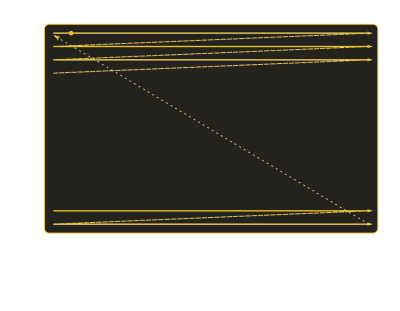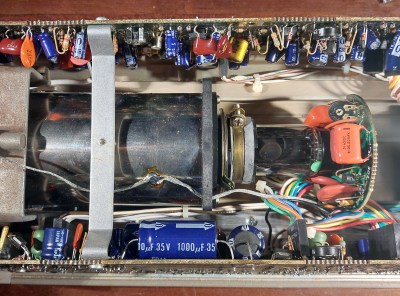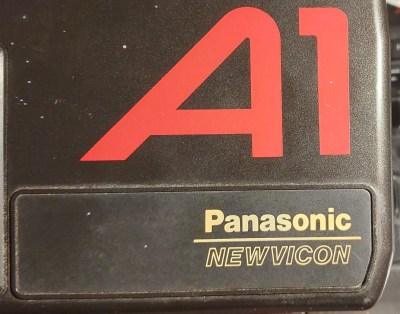Cameras are a funny rabbit hole to fall down as a hacker, because we have well over a century of items to pick and choose from, a lot of which can be had for relative pennies. In my case I have more of them than I’d care to mention, mostly film cameras and 8mm movie cameras, but there are one or two that are entirely different. My first interest in electronics came through PAL televisions, so it’s hardly surprising that along the way I’ve also acquired more than one chunky old tube-based video camera. These devices are now long ago supplanted by their solid state replacements, but they retain a fascination for me as the mirror of the CRT-based TV sets I know so well. It’s time for a fascinating descent into the world of analogue video.
Electrons chasing light, chasing electrons

The basic mode of operation behind all but some of the very earliest electronic camera tubes is that an electron gun paints its raster of electrons onto a light-sensitive target, and the current flowing through the electron beam varies in proportion to the light at each particular point on the target. This can be used to create a voltage, which when combined with the various sync pulses makes a video signal that would be understood by a monitor. The various different types of tubes have names such as Iconoscope, Emitron, or Vidicon, and while the main differences between those various types of tube lie in the combination of materials and design of their targets. Successive generations of tube made improvements to sensitivity and noise performance, first combining photoemissive layers with electron multiplying layers to amplify the video signal in much the same way as a photomultiplier tube does, and then using photoconductive targets to vary the conductivity of the target depending on the light at a particular point.
Time for some real cameras

The tube camera I’ve owned the longest is probably the best to have the lid off and see its internals, it’s an RCA security camera from the mid 1980s. Very sturdily built in the USA, mine is the 625-line version for the European market. Opening it up there’s another echo of the CRT monitor, with the same deflection and signal panels you’d find at the other end of the chain. On top is a sync generator panel, which is far more than a simple pair of oscillators. Instead it’s stuffed with circuitry to produce the full standard sync timings with odd and even fields. Lifting out the sync panel reveals the tube, in this case a vidicon with a photoconductive target, encased in its magnetic focus and deflection coils. This is a monochrome camera, so everything is pretty easy to understand.

When a colour analogue video camera is explained, it usually starts with a diagram of a light path with a couple of bean splitters and a set of filters to supply red, green, and blue images to three different tubes. This produced those high quality broadcast images, but at the expense of significant expense and complexity. As colour home video equipment appeared in the 1970s there appeared a demand for single-tube colour cameras, and to that end the manufacturers came up with a variety of similar tubes with RGB stripe filters over their targets. A couple of these cameras have come my way, both of which have Panasonic Newvicon tubes. These differentiate between red, green, and blue parts of the image by their amplitudes, and while the image is definitely colour, I’d be lying if I said it was broadcast quality.
Here in 2024 there’s very little reason to use a tube camera unless as I am you are seeking a partcular aesthetic, That said, they remain a fun and forgotten piece of consumer electronics to experiment with, so pick one up and have a play should you see one. Looking at the whole system of both camera and monitor it’s possible to see the beauty of analogue television, in the way that every part of the system exists in perfect synchronisation. Imagine the TV sets of a whole country tuned to the same channel, and all synchronised to within a fraction of a microsecond, and you’ll see what I mean even though the idea of everyone watching the same show together is now more than faintly ridiculous.
If this has tickled your fancy, here’s more from the PAL coalface.
Header: Kyle Senior, CC BY-SA 4.0.















“the idea of everyone watching the same show together is now more than faintly ridiculous”
What about live sports?
Are you sure you’re on the right site? :)
Yes, I know, plenty of tech-nerds also watch sports, but it’s certainly a smaller fraction than in the populace at large.
This reminds me of the random access storage tube used in the Manchester baby, the first programmable general purpose computer
It would write a grid of dots where each dot represents a single data but
relying on slow phosphor decay to temporarily store data
It reads the data by scanning the beam over again and turning a measured voltage into binary
Is that called a Williams tube?
Fun factoid:
When the Manchester computer was being designed, a significant issue was how to provide it with memory. The two solutions they came up with was Williams tubes, and acoustic delay lines.
However when Alan Turing was working at Bletchley park during the war he shared the hut he was working in with a guy who was researching electromagnetism – specifically he was trying to find a material with low remanence – i.e. something you could electromagnetise, but wouldn’t retain residual magnetism afterwards.
In later years magnetic memory was widely used in computers, but it seems the idea never occurred to Turing at the time.
So much more choice with sports now though.
Streaming video now uses protocols (e.g. HLS) which cache video to prevent stuttering and artifacts. This causes a +-2 second delay between streamse
What about NASA TV live stream? ;)
That is of course what I meant to say!
Tube camera can still be seen on high radiation environment, they usually survives longer than silicon sensors.
Wonder is electrostatic deflection is any better than electromagnetic
Well it’d act more like a capacitor, but with a discharge bleeder resistor, like a MOSFET gate
The resistor would set the deflection strength and the return speed… probably some clamping diodes as well
Voltage controlled deflection instead of current controlled, probably would use less power than a regular CRT
Faster raster speeds too
Would be relative to anode or plate voltage, a gate drive transformer and MOSFET or igbt could easily handle that
Up to a few kv peak
Don’t need that much for deflection
And with the MOSFET driver you can plug it in your esp32, propeller, or whatever Arduino thangamajig to drive the pulses and read the line data
Use a half bridge to sink and source the current in a electrostatic deflection, theyd be operating out of phase, and one n channel and one p channel
Would also allow more control of the deflection speed and strength theoretically atleast
Relative to the center tap, point between the bridge
Just don’t turn both MOSFET full on simultaneously
Might Lose that blue smoke technology that’s inside
But electron beam is inside a metal tube there, also focusing is magnetic. Not sure if strong E-field wouldn’t mess up the tiny signal that is picked up at the front ring also. Just some concerns.
Electrostatic deflection causes serious problems with focus and image linearity that magnetic deflection does not have. Electrostatic tubes (like the CRT in oscilloscopes) are very long in order to minimize (but not eliminate) the problem. The issue is that electrostatic deflection causes a change to the momentum of the electrons proportional to deflection angle, but magnetic deflection does not.
My first job was in the emi research labs making an electrostatic videcon camera tube. These were uses to make small cameras which were used for pipe inspection since they did not require the magnetic coils of magnetic videcons. They were only ever made in small quantities, maybe a hundred a year s were kept for specialist applications. I still have a couple made on my shelf.
Faster scan times and less power is why the electric deflection tubes were used in oscilloscopes.
I have an old CCTV camera out in the garage, with a 24 volt supply.
Just haven’t gotten around to hooking it up to anything.
Good thing I recently acquired a small CRT TV to feed it into.
As beam voltage goes up for brightness the voltage to deflect goes up also. High voltage even for tubes. There were about 2 or 3 deflection plate picture tubes ever made and driving coils is hard till exploited for current and the switching power supply was born.
Current driven feedback to an op-amp in a vector game CRT enables voltages from the game to make the right moves despite what happens when driving a coil.
It’s mostly simple design same for both ends. 4 more seal connections vs. no contact magnetic coupling.
“Imagine the TV sets of a whole country tuned to the same channel, and all synchronised to within a fraction of a microsecond, and you’ll see what I mean”
And all picking that signal right out of the air.
There is an episode (“Krampus”) of the TV horror anthology series /Inside Number 9/ that was shot as a fake show from the seventies, and used whatever model of analogue video camera the BBC would actually have used at the time.
You can tell it’s not just a filter, because at points the characters carry lit candles, which leave streaks on the screen due to the flame oversaturating the photosensitive thingamagubbins. If you started with modern video, a flame would read the same as a well-lit sheet of paper, i.e. they’re both 255, so you wouldn’t know which pixels were overexposed. Even with HDR footage, probably.
I agree that tube cameras are a fantastically interesting niche. You can get them very easily and cheaply on ebay and they have an aesthetic that I love, probably due to being a gen Z who’s primary association of that look is with Doctor Who and Top of the Pops instead of the news. Somewhat embarrassingly, I have about 4 of these cameras that all work, but haven’t used them for anything because the two portable VCRs I have to use them with don’t work, I haven’t managed to fix them yet and I don’t want to cut the cables and modify them to output phono as I still want to use them with the VCRs eventually. All of them I bought between 2021 and 2022, so I’ve had them for a little while now and need to sort them out in the next year.
If you remember, there was a hackaday article on tube cameras from about 2019 or 2020 framing it as “what came before CCDs”. It might not be the case for people who lived in that era (time of the tubes), but it is easy now to assume without thinking, that electronic video came with the CCD sensor, and before that everything was done with film, which is of course not true. I think that article was my first exposure to the concept of tube cameras, but it was a while later after binge-reading the website Total-Rewind (mostly about VCRs) that I became interested in camera-VCR separates systems and by extension tube cameras, as that is the type of most of those cameras.
Like you said, it is a rabbit hole and a half and if you read about all the different tube image sensor designs, there is almost every combination and perturbation of how they can be designed. Some store positive charge, some store negative, some early one don’t store at all etc.
Another interesting detail is that most of those single tube colour cameras in fact do not use RGB stripe filters. It is easy to assume that would be the most simple way of doing it, but it relies on you knowing exactly when the beam is lined up with a specific colour. Consequently, only cameras with special tubes with an extra electrode to detect beam position (Sony Trinicon and Hitachi Diode Gun (I think)) use the straightforward RGB filter. The rest of the designs use a standard monochrome tube with a filter with for example, blue, cyan and clear stripes. This means that given the resolution of the tube or the image projected onto the tube is not higher than the stripe filter (to allow all 3 colour stripes to be over a “pixel” of the same value), the point at which the first blue stripe has been reached can be determined as the intensity will drop at that point after passing the previous clear stripe. The blue stripe lets blue light through, cyan lets blue and green through, and clear lets all of it through. So the ratio of colour intensities can be determined, but the intensity will always be at its lowest on the blue stripe, and will only stay the same or go up until it drops again at the next blue stripe.
you might be interested to search AliExpress for “MiniDVR”.
Thanks. That is quite a cool device that would more convenient than a capture card on a PC. I also have a JVC miniDV camcorder that works that will record composite input, but I haven’t wanted to modify any of the cameras to not have the original CCJ plug anymore, as I don’t have easy access to a female socket that I could use to make an adaptor. I guess it won’t hurt to do it to one of them.
Tube cameras had been “normal” technology until circa the end of the 80s.
Beginning with the 90s, CCD and CMOS cameras had become the norm.
Nowadays, CCD cameras are vintage, too. Previously, CCD sensors still had been popular in webcams and early HD camcorders.
I’d be surprised to find any beans, split or whole, inside a video camera…
Are you now splitting hairs too?
I spotted the error too!
But I also understand what they meant to say!
So I give people a break for making typos!
When I was a young man in high school I didn’t internship program and I was a videographer for an NBC affiliate and we use three quarters inch videotape and the cameras were so expensive that they call them a little Mercedes Benz, so don’t drop it or you’ll be paying a whole lot of money! That’s what they told me! But it was so cool I got to cruise around and then go in and edit it out in the editing suite of a really nice editing studio where they had two decks made for those larger format cassette tapes because they were much higher quality. You can just store more information on a 3/4 inch tape then a half inch tape if it was even half inch?
But we had like a in and out times and you could set your times and cut and fade and it was all manual It wasn’t on a computer at all It was a big huge sweet with a manual controller in front of you and you would set the times and it would then cruise through once you got it exactly where you wanted it and got maybe some if there were audio taken separately you’d have to sync their lips.
It took quite a bit of work to edit a newsworthy piece of video and I was doing it as a teenager. I had already worked at PBS the public broadcasting service in our local area and for them I was in a dark room I did photographs and was on the yearbook photograph I was a photographer for the yearbook They sent me to photojournalism camp instead of bandcamp at Ball State University which is really good for that. But they sent us out with a professional photographer everyday and he would give us some subject matter to seek out and then he would critique our negatives and send us back out with a new role.
That’s really cool it’s interesting to see that I have a teckonics/sony 323 oscilloscope that I’m rehabbing but it’s absolutely spotless as it was maintained by the Swiss military. I picked it up for only 20 francs at the Swiss military surplus shop. We have a real big warehouse version right near where I live in this capital city of Bern.
It’s so well maintained and spotless The only things that are worn out are the d sized nickel academy on batteries which I’m not sure they were even using but the interior there’s not a bit of dust in it and maybe I should check the caps but I’m wondering if it’ll just work right off the bat???
The guy who sold it to me was insistent that I take this special piece which was a clear cover for the cathode ray tube window which is quite small given the tube is very large and long I think it’s a shield for some radiation.
Could be for attaching a camera to capture the CRT images.
I don’t even have a hard time thinking in the imperial system I’ve been abroad for 20 years. I’m going to do a national or Swiss and American.